From antiquity to the present, Nepal has remained an epicenter and a sanctuary of Dharmic activity—a place of cross-pollination and preservation of ancient traditions. Nepal is magnificent in its dichotomies and seeming contradictions that have blended over time to create a sophisticated and saturated culture. It is a Hindu nation which evolved symbiotically alongside Buddhist kingdoms, the holy land where Shakyamuni Buddha was born, and a place where the lineage of Buddhist priests are bound by caste.
Amidst the chaos, challenges, and pollution of a developing country, the ancient capitals of Kathmandu, Patan, and Bhaktapur maintain their rich heritage. These cities abound with medieval temples and shrines, revealing the nation’s rich history and culture.
The native people who built this ancient civilization are the Newars, revered for thousands of years as masters of Buddhist sculpture, painting, and architecture. Their priests, known as Vajracharyas, descend through a family lineage and caste system, similar to the Brahmins of India.
The Vajracharya priests maintain a Buddhist dance tradition that dates back over a thousand years and has remained, for the most part, hidden from the world. This ritual art is known as “Charya Nritya,” which means “dance as a spiritual discipline.” In this lineage, practitioners offer devotional songs and dance as ritual ceremonies, meditation, and training in the physical yogas. To the Vajracharyas, followers of the Hevajra Tantra, singing and dancing are prerequisites to enlightenment. Yogis and yoginis therefore perform Charya Nritya as a path of realization.
Charya Nritya is a method of deity yoga that integrates body, speech, and mind techniques. It is a meditative discipline that involves physical training and spiritual transformation. Practitioners engage in visualization, recitation of mantras, sacred hand gestures, foot movements, and yogic postures, and adorn themselves with the crown and ornaments of a deity.
As a classical dance, Charya Nritya is distinctly South Asian in aesthetic and style. Dancers perform to flowing ragas and melodic chacha songs written by accomplished Vajrayana masters. These devotional songs, known as “Charya Giti,” supplicate, describe, and praise the deity in Sanskrit. Songs are accompanied by musical cymbals, or ta, and a hand-held hourglass-shaped drum, or damaru. The dances portray the stories of Buddhas and bodhisattvas, interpreting the songs through codified hand gestures, or mudras.
Dancers convey the iconographic symbolism of deities and depict their accomplishments and supreme methods. Displaying the asanas or sculptural postures of Buddhas and bodhisattvas in trifold tribhangha stance, dancers move fluidly from one pose to another. The dance is a transcendental journey into the heart of the mandala. Through this ritual enactment and meditative experience, practitioners identify themselves with the activity, appearance, and qualities of a deity, and in doing so, cultivate wisdom, compassion, and skillful means.
In Newar Buddhism, the body is viewed as a mandala, a sacred microcosm of the universe that consists of five elemental qualities: earth, water, fire, air, and space. Mudras activate these elements within the body and play an essential role in the dance. As part of training and preparation, practitioners engage in hand exercises for energetic flow and flexibility. When offering the dance, mudras are powerful wisdom seals to generate and invoke the deity.
An important and lesser-known aspect of Charya Nritya is as a physical yoga and healing art. Yogic practices train and prepare a dancer to engender the spiritual qualities of the deity. Breathing exercises or prana yoga circulate the flow of subtle energy. Foot exercises stimulate organs and bodily systems, while the four basic steps of the dance balance masculine and feminine power. Before dancing, practitioners may engage in seated meditations that include visualizations and mantras to open the chakras and awaken the senses. The dancer will also undergo the process of generating the deity. These esoteric disciplines are said to maintain youth and vitality, and to nourish a practitioner’s energy channels and subtle body.
All aspects of Charya Nritya train a dancer in Buddhist principles. For example, when a dancer dresses, the deity’s ornaments represent the six paramitas or perfections. The crown is viewed as symbolizing meditative concentration, the necklace as generosity, earrings as patience, bracelets and anklets as discipline, belt as effort, and adorning the third eye as wisdom.
Charya Nritya is exclusive in its portrayal of the Buddhist pantheon of peaceful and wrathful deities. The Newar tradition is a singular contrast to South and Southeast Asian classical dances that dramatize Hindu mythology, despite their countries’ long and rich histories of Buddhism. Throughout these regions, Buddhist art and architecture of antiquity portray temple dancers engaged in spiritual practice. These dances, ceremonial offerings to awaken the Buddha within, remain frozen in time on temple walls, windows of the past. Manuscripts with songs written by mahasiddhas remain; however, the dances that accompanied these songs have long become extinct. Charya Nritya, preserved by the Vajracharya priests of Nepal, may be one of the last surviving vestiges of the Buddhist dance traditions that once spanned empires and civilizations of centuries past.
Within contemporary society, there are challenges to maintaining the lineage as a spiritual practice. In the last 20 years, Charya Nritya has become recognized as a classical dance, transitioning from the temples to the theatre. This was the case for all classical dances with roots in spiritual practice. However, Nepal sidesteps the outcome of other traditions, where the ancient died in lieu of modern context. Charya Nritya is an exception as Vajracharya priests continue to maintain the lineage as a yogic discipline. Despite the problems of secularization, genuine practitioners seeking to engage in the art as meditation continue to receive initiation and instruction.
FEATURES|THEMES|Music
Charya Nritya: Ancient Buddhist Dances of Wisdom and Healing in the Modern World
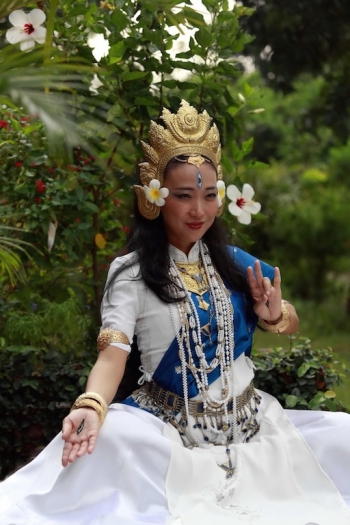 White Tara, LiAnne Takeuchi Hunt. From Ken Tam
White Tara, LiAnne Takeuchi Hunt. From Ken Tam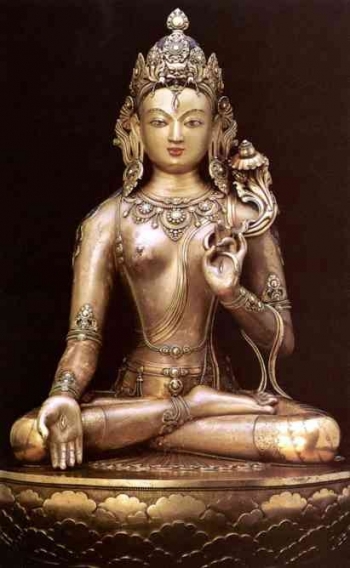 White Tara statue. From huntington.wmc.ohio-state.edu
White Tara statue. From huntington.wmc.ohio-state.edu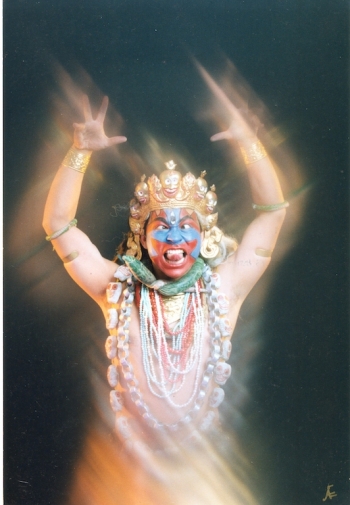 Vajrapani, Prajwal Ratna Vajracharya. From Andre Elbing
Vajrapani, Prajwal Ratna Vajracharya. From Andre Elbing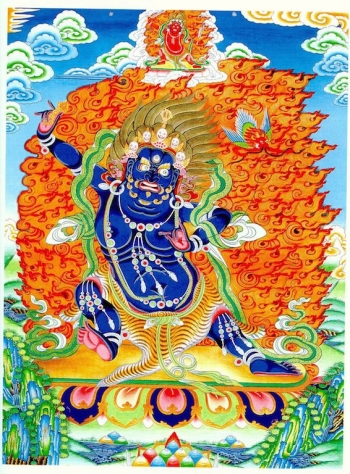 Vajrapani thangka. From bodetam.org
Vajrapani thangka. From bodetam.org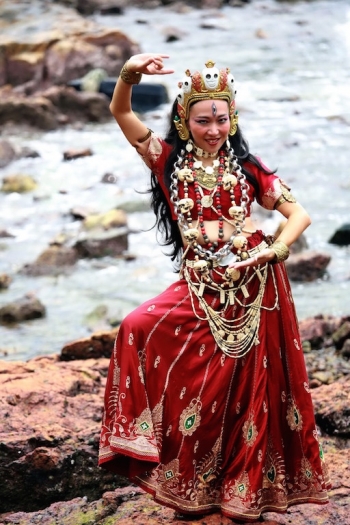 Vajravarahi, LiAnne Takeuchi Hunt. From Ken Tam
Vajravarahi, LiAnne Takeuchi Hunt. From Ken Tam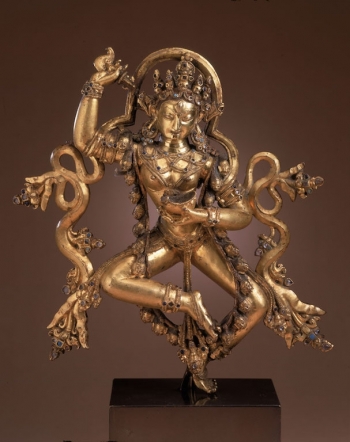 Vajravarahi statue. From huntingtonarchive.osu.edu
Vajravarahi statue. From huntingtonarchive.osu.eduCharya Nritya is a meditation, yogic discipline, and dance of enlightenment to support practitioners on the path. It continues as a living tradition amongst the Newar Buddhists of Kathmandu and is being adopted by Buddhists of all lineages wishing to incorporate the physical yogas in their meditation practice.
Ultimately, Charya Nritya is a vehicle for the deity to manifest, and is given the title rupa, which in Sanskrit makes reference to sculpture or a container. Like Buddhist sculpture, the dance is a container and symbolic representation of enlightenment, albeit through a living, breathing, sentient being. Yogis and yoginis dance to transcend ordinary existence, and through the practice of Charya Nritya, offer their body, speech, and mind as a vessel for enlightenment’s display. Thus, an accomplished Charya Nritya practitioner’s role when offering the dance is to bring the Buddhas and bodhisattvas to life.
LiAnne Takeuchi Hunt is a student of Prajwal Ratna Vajracharya, a 35-generation Newar priest and founder of Dance Mandal Foundation of Buddhist Arts of Nepal and Nritya Mandala Mahavihara temple, based in Portland, OR, USA. Since 2001, she has dedicated herself to the study and preservation of Charya Nritya and is a recipient of multiple awards and grants for her work. LiAnne resides in Hong Kong and is establishing a branch of Dance Mandal to serve the larger Asia region.
For more information, see:
Dance Mandal
Dance Mandal Hong Kong
Dakini As Art - LiAnne Takeuchi Hunt
Core of Culture - Charya Nritya
Moving the World with Sacred Mudra: Buddhist Dance from Nepal to Oregon to Brazil














